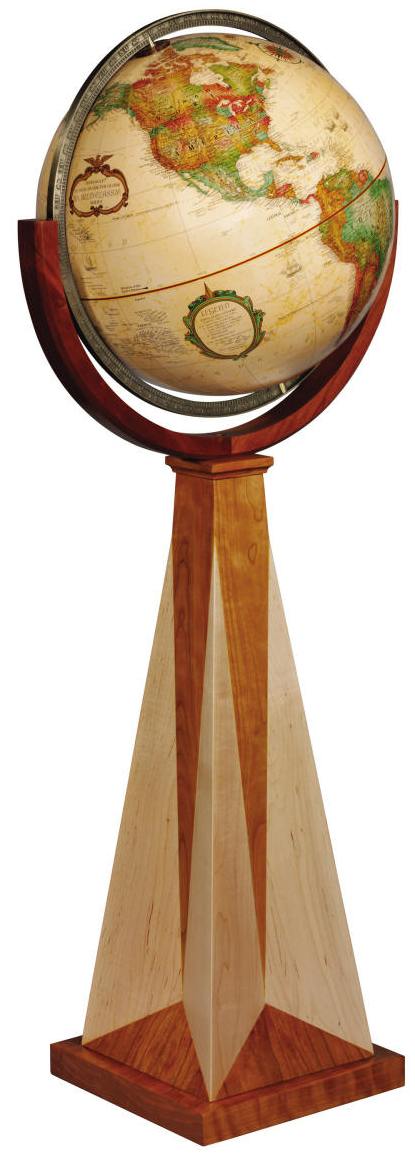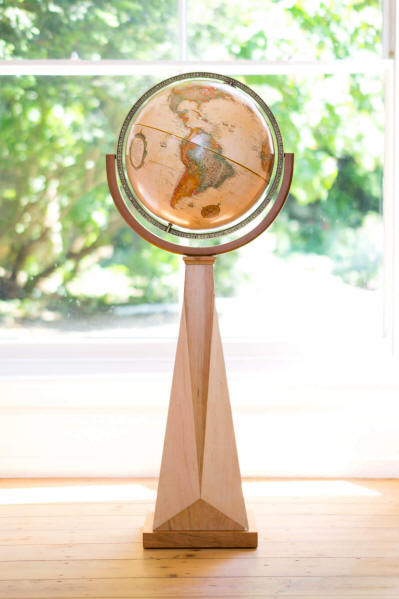Obelisk -
Floor Standing Globe by Replogle
-
Sale
Price: $1,595 (free
shipping/handling)
Retail
$
1899.00
or 6 installments of
$265.83 with
PayPal Credit
Use COUPON CODE
"10NOW" for an additional
10% DISCOUNT
 |
The Obelisk modern globe is inspired by a design of Frank Lloyd
Wright (1867 - 1959), considered to be America's greatest architect.
The cherry and maple hardwood combination* of the pedestal is a striking adaptation
of one of Mr. Wright’s vase designs. This was one of several concepts that he
developed in 1929.
The Obelisk's impressive
50-inch height and the clean lines of the solid hardwood
base provide an attractive backdrop for its 16-inch diameter ball.
Features a fully up
to date political map with antique color
ocean.
Globe Model #22728
In Stock
Ready to ship in 1-2 days
Delivery: 1-5 days

| Globe
Diameter: |
16" (40 cm) |
| Globe Height: |
50" |
| Width: |
20.5" |
| Illuminated: |
No |
| Language: |
English |
| Place Names: |
4,100 |
| Globe Surface: |
Raised Relief ** |
| Ocean Color: |
Antique |
| Cartography: |
Current |
 Made in USA
Made in USA
*
Wood Finishes -
additional colors
available upon request.
Full-swing
antique style brass-plated
die-cast meridian (ring supporting the globe)
allows the ball to be turned 360°
for easy access to
thousands of points of interest
from any possible angle.
The
globe revolves within the meridian ring (East/West), and the meridian
swings within the
stand (North/South).
* A portion
of this globe's sales supports the conservation and education programs
of the Frank Lloyd Wright foundation.
|
|
Call us toll-free 877-822-9889 or
812-333-2772 for orders/questions Mon.-Sat.
10:00 am-5:30 pm Eastern Standard Time
Raised Relief to better emphasize the
mountainous areas of the world - there are ‘bumps’ on some areas of the
globe. They are called raised relief. They are there so that you
can ‘SEE & FEEL’ the mountains - although their actual height on the
globe does not have any relationship to the true relative heights of the
mountain ranges.
to better emphasize the
mountainous areas of the world - there are ‘bumps’ on some areas of the
globe. They are called raised relief. They are there so that you
can ‘SEE & FEEL’ the mountains - although their actual height on the
globe does not have any relationship to the true relative heights of the
mountain ranges.
 Updatable World Globe Program:
keep your globe as up to date and
accurate as the day you bought it. You are eligible for 50% off the retail
value of a new globe ball or ball and ring through the Updatable Globe
Program. To take advantage of this offer available in USA and Canada, make
note of your globe model (5-digit number on carton) and the month and date
of purchase and keep this information in a safe place. If a change occurs in
the world, you can request an update. Updatable World Globe Program:
keep your globe as up to date and
accurate as the day you bought it. You are eligible for 50% off the retail
value of a new globe ball or ball and ring through the Updatable Globe
Program. To take advantage of this offer available in USA and Canada, make
note of your globe model (5-digit number on carton) and the month and date
of purchase and keep this information in a safe place. If a change occurs in
the world, you can request an update.
Frequently
Asked Questions
FINDING PLACES ON YOUR GLOBE: Although a globe
is round, with no beginning or end, there are two main reference lines from
which all distances and locations are calculated. One is the equator,
running east and west around the middle of the globe, dividing it into two
equal halves. The other is the prime meridian, an imaginary line running
from pole to pole and cutting through Greenwich, a section of London,
England. Both of these lines are 0º and the globe numbering system starts at
the point where they intersect. All lines running east and west, parallel to
the equator, are called latitude lines. They are sometimes referred to as
parallels because they are parallel to each other. Latitude lines are shown
at 15º intervals north and south of the equator. Look at New Orleans on your
globe and you will find it located at 30º. Since it is north of the equator,
we say it is 30º north latitude, or 30N. The lines running north and south
from pole to pole are called longitude lines, sometimes referred to as
meridians. Longitude lines are numbered along the equator on your globe at
15º intervals east and west of the prime meridian at Greenwich. Again using
New Orleans as an example, we find it located at 90º or 90º west of 0º
longitude. Thus, New Orleans is located at 30N latitude and 90W longitude.
Prime Meridian Latitude lines determine angular distances north or south of
the equator. Longitude lines determine angular distances east or west of the
prime meridian. Remember, latitude lines go from 0º at the equator to 90º at
the poles. Longitude lines go from 0º at the prime meridian to 180º, a point
on the exact opposite side of the globe. In giving a position, latitude is
always stated first. Lines of latitude and longitude appear on your globe
only at certain intervals; otherwise, they would cover up all other map
detail.
USING THE TIME DIAL: You can
tell the time of any place on Earth by counting the number of meridians and
figuring one hour later for each one east of you or one hour earlier for
each one west of you. Your globe has a time dial loosely capped over the
north pole, and you will see that it is divided into twenty-four equal
parts, each representing one hour (or one meridian). Numbering is from noon
to midnight and from midnight to noon. Half the dial is dark to indicate the
darkness hours from sunset to sunrise and half is light for daylight hours.
Let us suppose you are in St. Louis. It is 10:00 A.M. and you want to know
the time in Paris, in Cairo, and in Tokyo. Set the time dial so that 10:00
A.M. is directly in line with St. Louis, sighting along the 90ºW meridian.
Now rotate the globe (the time dial turns with it) until you find Paris.
Sighting up along the nearest meridian, you find it is 4:00 P.M. Turn the
globe to Cairo and repeat the procedure. It is 6:00 P.M. there. Now,
rotating the globe all the way to Tokyo, you find the day is over and it’s
1:00 A.M. the next morning.
|
Obelisk
Floor World Globe by
Replogle Globes, Item #
22728
Sale Price:
$1595.00, Inspired by Frank Lloyd Wright Design, Current Cartography, Raised Relief,
World Globe on Stand, Wood Floor Stand
World
Globes make great gifts for Geography Buffs, Mother's Day, Father's Day & Graduation. Perfect as Wedding, Anniversary, Retirement Gifts, Corporate Awards, Business & Executive Gifts, Bon Voyage & Birthday Presents
|






